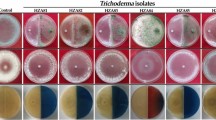Abstract
Of 24 fungi belonging to more than five genera isolated from tubers of rotten Helianthus tuberosus, 11-inulinolytic active isolates were able to develop halo zones around their fungal colonies, indicating inulinase activity. Alternaria, Aspergillus, Fusarium, Pencillium and Trichoderma were the most common inulinolytic genera, representing more than 90 % of the total positive inulinolytic fungi. Aspergillus tamarii and Pencillium citrinum quantitatively recorded better growth (5.5 and 4.7 mg ml−1) and inulinase production (21.53 and 20.15 U ml−1) in submerged culture. The enzyme preparation showed also invertase activity. Aspergillus tamarii, as the most potent producer of inulinase, was identified using the Inter Transcribed Spacer marker. The sequence comparisons showed that our molecularly identified strain (GU295949) is related more closely to A. tamarii strains of the gene bank. Statistical screening using the fractional factorial Plackett-Burman design with 12 run was applied for screening ten variables, the low levels of pH (4.8), inoculum size (103 spore g−1), NH4NO3 (1.0 mg g−1) and MgSO4 (0.12 mg g−1), were the most significant variables on A. tamarii inulinase production. The high inulinase/invertase ratio (1.841–4.293) classified the enzyme preparation as inulinases, which can be used efficiently in production of fructose syrup from tubers of H. tuberosus.






Similar content being viewed by others
References
Booth C (1971) The genus Fusarium. Commonwealth Mycological Inst, Kew
Domsch KH, Gams W, Anderson TH (1980) Compendium of soil fungi, vol 1. Academic Press, London
Edwards R, Blount JW, Dixon RA (1991) Glutathione and elicitation of the phytoalexin response in legume cell cultures. Planta 184:403–409
El-Hersh MS, Saber WIA, El-Naggar NE (2011) Production strategy of inulinase by Penicillium citrinum AR-IN2 on some agricultural by-products. Microbiol J 1(3):79–88
Ellis MB (1971) Dematiaceous hyphomycetes. Commonwealth Mycological Inst, Kew
Ettalibi M, Baratti JC (1987) Purification, properties and comparison of invertase, exoinulinases and endoinulinases of Aspergillus ficuum. Appl Microbiol Biotec 26:13–20
Gilman JC (1957) A manual of soil fungi. Iowa State University, Ames
Holker U, Lenz J (2005) Solid-state fermentation: are there any biotechnological advantages? Curr Opin Microbiol 8:301–306
Inglis PW, Tigano MS (2006) Identification and taxonomy of some entomopathogenic Paecilomyces spp. (Ascomycota) isolates using rDNA-ITS sequences. Genet Mol Biol 23:132–136
Jing W, Zhengyu J, Bo J, Augustine A (2003) Production and separation of exo and endoinulinase from Aspergillus ficuum. Process Biochem 39:5–11
Kalil SJ, Suzan R, Maugeri F, Rodrigues MI (2001) Optimization of inulinase production by Kluyveromyces marxianus using factorial design. Appl Biochem Biotechnol 94(3):257–264
Kango N (2008) Production of inulinase using tap roots of dandelion (Taraxacum officinale) by Aspergillus niger. J Food Eng 85:473–478
Kumar GP, Kunamneni A, Prabhakar T, Ellaiah P (2005) Optimization of process parameters for the production of inulinase from a newly isolated Aspergillus niger AUP19. World J Microbiol Biotechnol 21:1359–1361
Nakamura T, Ogata Y, Shitara A, Nakamura A, Ohta K (1995) Continuous production of fructose syrup from inulin by immobilized inulinase from Aspergillus niger mutant 817. J Ferment Bioeng 80:164–169
Ohta K, Hamada S, Nakamura T (1993) Production of high concentrations of ethanol from inulin by simultaneous saccharification and fermentation using Aspergillus niger and Saccharomyces cerevisiae. Appl Environ Microbiol 59:729–733
Ohta K, Suetsugu N, Nakamura T (2002) Purification and properties of an extracellular inulinase from Rhizopus sp. Strain TN-96. J Biosci Bioeng 1:78–80
Onodera S, Shiomi N (1992) Purification and subside affinities of exo-inulinase from Penicillium trzebinskii. Biosci Biotechnol Biochem 56:1443–1447
Plackett RL, Burman JP (1946) The design of optimum multifactorial experiments. Biometrika 33:305–325
Raper KB, Fennel DI (1965) The genus Aspergillus. Williams and Wilkins Baltimore, USA
Raper KB, Thom C (1949) A manual of penicillia. Williams and Wilkins Baltimore, USA
Ronkart SN, Blecker CS, Fourmanoir H, Fougnies C, Deroanne C, Van Herck J-C, Paquot M (2007) Isolation and identification of inulo oligosaccharides resulting from inulin hydrolysis. Anal Chim Acta 604:81–87
Saber WIA, El-Naggar NE (2009) Optimization of fermentation conditions for the biosynthesis of inulinase by the new source; Aspergillus tamarii and hydrolysis of some inulin containing agro-wastes. Biotechnol 8:425–433
Sanger F, Micklen S, Coulson AR (1977) DNA sequencing and chain-terminating inhibitors. Proc Natl Acad Sci USA 74:5463–5467
Sette LD, Passarini MRZ, Delarmelina C, Salati F, Duarte MCT (2006) Molecular characterization and antimicrobial activity of endophytic fungi from coffee plants. World J Microbiol Biotechnol 22:1185–1195
Sirisansaneeyaku S, Worawuthiyanan N, Vanichsriratana W, Srinophakun P, Chisti Y (2007) Production of fructose from inulin using mixed inulinases from Aspergillus niger and Candida guilliermondii. World J Microbiol Biotechnol 23:543–552
Skowronek M, Fiedurek J (2004) Optimisation of inulinase production by Aspergillus niger using simplex and classical method. Food Technol Biotechnol 42(3):141–146
Skowronek M, Fiedurek J (2006) Inulinase biosynthesis using immobilized mycelium of Aspergillus niger. Enz Microbial Technol 38:162–167
Somogyi M (1952) Notes on sugar determination. J Biol Chem 195:19–23
Turenne CY, Sanche SE, Hoban DJ, Karlowsky JA, Kabani AM (1999) Rapid identification of fungi by using the ITS2 genetic region and an automated fluorescent capillary electrophoresis system. J Clin Microbiol 37:1846–1851
Vandamme EJ, Deryke DJ (1983) Microbial inulinases: fermentation process, properties and applications. Adv Appl Microbiol 29:139–176
White TJ, Bruns T, Lee S, Taylor JW (1990) Amplification and direct sequencing of fungal ribosomal RNA genes for phylogenetics. In: Innis MA, Gelfand DH, Sninsky JJ, White TJ (eds) PCR protocols: a guide to methods and applications. Academic, New York, pp 315–322
Author information
Authors and Affiliations
Corresponding author
Rights and permissions
About this article
Cite this article
Abd Allah AbdAl-Aziz, S., El-Metwally, M.M. & Ismail Ali Saber, W. Molecular identification of a novel inulinolytic fungus isolated from and grown on tubers of Helianthus tuberosus and statistical screening of medium components. World J Microbiol Biotechnol 28, 3245–3254 (2012). https://doi.org/10.1007/s11274-012-1134-y
Received:
Accepted:
Published:
Issue Date:
DOI: https://doi.org/10.1007/s11274-012-1134-y




